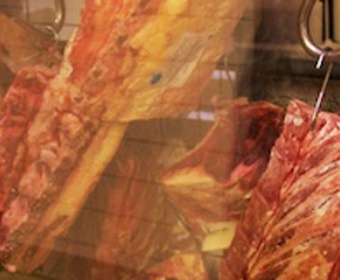
How to choose meat
- Look for telltale fat, "marbling", for more taste.
- Cold meat should – due to a high level of fat – be firm.
- Do the right thing with the right cut of meat.
- Ask your butcher for advice and cultivate your relationship with him or her.
- "Less but better" is a good strategy
Sadly, you can’t always count on the meat you buy in a store comes from a high quality source. Here are some tips that make it easier for you to find the correct raw material.
Fat level
Marbling - interspersed fat – gives a deeper, more delicious taste. Feel and squeeze the meat in the refrigerated display. It should feel firm, as cold fat is hard. A fatty coating also contributes to helping the meat retain its juice and taste while cooking. Older animals – with more yellow fat – can be less tender, but the meat often has a deeper, more mature taste.
Tenderizing
Meat from veal, lamb, pork and poultry is consumed directly, whereas beef needs to tenderize over one or two weeks. Meat that is hanged to tenderize develops a great taste and loses considerable liquid, which is a one reason why it is more expensive. But the difference in price can be seen as good business since you don’t have to pay for water, which would anyway disappear during cooking.
Feed
Animals that graze build meat and fat in natural proportions. Green grass gives a tastier meat and – even better – more deliciously interspersed fat than other feeds. Spanish Pata Negra pigs, which are raised on acorns, corn-fed chicken and calves that have been fattened convincingly show how different feeds can change the taste of meat considerably.
Happy animals
We have a moral obligation to make sure all animals have a decent life. Luckily for those of us who appreciate good meat, there is a connection between good animal husbandry and good quality meat.
Price and result
When you buy cheap meat, it is likely that you are paying for added saltwater. It is better to opt for a smaller sized, but nicer and more tastier cut that is not transformed into a pool of liquid in the pan. Estimate 120-200 grams per person depending on the menu and company and the quality of the meat.
Learn how to cut up a chicken so you can buy them whole. You will get a better price, more beautiful pieces (with the skin) and you can prepare an extremely useful broth from the bones. It is simple: Boil the bones with an onion and a carrot, turn off the cooking plate and leave with the lid on overnight. Next day, strain. Voilá, that’s it!
The right meat for the right purpose
There is a strong trend – started by skillful, knowledgeable meat cooks – to select less exclusive cuts of the animal that demand longer or slower cooking. A muscle that has worked a lot during the lifetime of the animal is less tender, but usually has more taste. You achieve a greater taste experience for a lower price – which, as a bonus, can be prepared beforehand.
“It is not only a matter of an excellent cut of meat. The knowledge and the processing also makes the cut of meat excellent.”
- Anna Lindblad, Bistro Nouveau
Packaged meat:
- Should be firm when chilled.
- The darker meat, the richer taste. The color should be clear, deep and red.
- Avoid meat that is brown at the edges or grayish.
- The meat should be firm and dry, never wet and wobbly.
- Marbling (interspersed fat) gives juicier meat and more taste.
- The pieces should be evenly and carefully cut.
- Avoid processed, pre-spiced, pre-marinated meat – which usually is produced from lower quality cuts.
- Smell, look, feel and rely on your own judgment.
Read the label
The information on the label is usually inadequate, but read it anyway. If you want to know more, ask the staff. By being more demanding, we can get better, tastier meat in our shops.
Tips from the meat chef 1:
Every chef that Professional Secrets has contacted says the same thing: “You get what you pay for.” Very, very cheap meat will not be very, very good. For an excellent result, you have to invest money in excellent raw material.
Tips from the meat chef 2:
When you have found a reliable and skilled butcher, cultivate your relationship. Get to know him or her by their first name.
While you’re at the butcher store
Try to pick up some broth, or at least some bones.
Sex, age and breed
All around the world, the past few decades have seen more and more people becoming increasingly interested in cooking, which in turn is leading to greater interest in getting quality produce. When it comes to meat, more of us are becoming curious about what helps ensure quality, including the importance of the sex, age and breed of what you are buying.
The sex of an animal is usually important when it comes to beef selection, where the female tastes the best. Castrated bull, steer or bullock, is also tastier. Age is more important than sex for animals that are slaughtered before they reach sexual maturity.
A milk cow that has calved and been slaughtered before the age of five years has the most delicious, tastiest meat. Steers too produce nice meat because castration slows the growing process in the animal, while increasing the amount of fat in the meat. If you can, avoid meat from animals older than four years old. When it comes to poultry, younger animals are more tender, but not necessarily more tasty.
Recommended cuts of meat from beef countries like Brazil, USA and Argentina are not necessarily tender. A tip from some of the most skillful meat chefs reads like this: Don’t necessarily choose the most tender meat, instead go for the most delicious. Meat that needs to be worked a little harder by your jaws often packs more taste.



